Could It Be Magic
| "Could It Be Magic" | ||||
|---|---|---|---|---|

A-side label of US vinyl single
|
||||
| Single by Barry Manilow | ||||
| from the album Barry Manilow | ||||
| B-side | "I Am Your Child" | |||
| Released | June 1975 | |||
| Format | 7" single | |||
| Recorded | 1973 | |||
| Genre | Pop | |||
| Length | 6:50 4:14 (edit) |
|||
| Label | Arista | |||
| Writer(s) |
Barry Manilow, Frédéric Chopin (music) Adrienne Anderson (lyrics) |
|||
| Producer(s) | Barry Manilow, Ron Dante | |||
| Barry Manilow singles chronology | ||||
|
||||
| "Could It Be Magic" | ||||
|---|---|---|---|---|

US 7-inch vinyl single
|
||||
| Single by Donna Summer | ||||
| from the album A Love Trilogy | ||||
| B-side | Whispering Waves | |||
| Released | January 11, 1976 | |||
| Format | 7" single | |||
| Genre | Disco | |||
| Length | 5:19 | |||
| Label |
Oasis (US/Canada) GTO (U.K.) Atlantic (France/Germany) Groovy (Netherlands) Durium (Italy) |
|||
| Writer(s) |
Barry Manilow, Frédéric Chopin (music) Adrienne Anderson (lyrics) |
|||
| Producer(s) | Giorgio Moroder, Pete Bellotte | |||
| Donna Summer singles chronology | ||||
|
||||
| "Could It Be Magic" | ||||||||
|---|---|---|---|---|---|---|---|---|

UK Maxi-CD cover
|
||||||||
| Single by Take That | ||||||||
| from the album Take That & Party | ||||||||
| Released | November 30, 1992 | |||||||
| Format | 7" single, 12" maxi single, CD single, Cassette single | |||||||
| Genre | Pop | |||||||
| Length | 4:28 (album version) | |||||||
| Label | RCA | |||||||
| Writer(s) |
Barry Manilow, Frédéric Chopin (music) Adrienne Anderson (lyrics) |
|||||||
| Producer(s) | The Rapino Brothers | |||||||
| Take That singles chronology | ||||||||
|
||||||||
|
||||||||
"Could It Be Magic" is a song with lyrics written by Adrienne Anderson and music composed by Barry Manilow, based on chord and melodical progressions of Frédéric Chopin's Prelude in C Minor, Opus 28, Number 20. Initially released in 1971, it was later rerecorded, given an album release in 1973 and a single release in 1975. This became one of Manilow's first hits. The song has been covered by a number of other artists over the years, most successfully by Donna Summer in 1976 and by Take That in 1992.
As Manilow had only composed or arranged commercial jingles up to that point, he was unproven as a pop-song arranger, and thus, he was not permitted to arrange the original backing track himself upon its first release in 1971. Instead, this early version of the song was produced under the hand of Tony Orlando and recorded by Featherbed, a "ghost" group consisting of session musicians.
Originally released on the Bell Records label, the composer hated the Tony Orlando arrangement so severely (see Sweet Life) that, as Manilow has said in numerous subsequent interviews, he was appreciative of the fact that the song went nowhere on the charts. However, he has been quoted in recent years as having somewhat softened his opinion of the track, saying it's "kind of catchy".
Featuring a bubblegum pop beat, cowbells and a "Knock Three Times" feel, the chorus is the same, but the original verse lyrics have nothing to do with the hit version Manilow himself released in 1973.
That year, Manilow would come to be signed to Bell Records in his own right, immediately after which a completely reworked version with Manilow's own arrangement was included on his debut album, Barry Manilow I, released that fall. Six months later, former Columbia Records president Clive Davis would take over Bell Records and merge it into Arista with all the other Columbia Pictures-owned labels such as Amy, Mala, Colpix, and Colgems, to name a few.
...
Wikipedia
